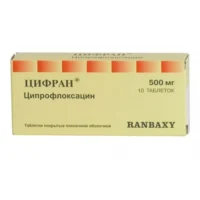Description
Nifuroxazid (Nifuroxazide) Coated Tablets 0.1 g №30
Ingredients
- Active ingredient: Nifuroxazide 0.1 g per tablet.
Dosage
- Adults and children over 6 years: Take 1 tablet three times a day after meals.
Indications
- Nifuroxazid tablets are indicated for the treatment of acute infectious diarrhea.
Contraindications
- Do not use Nifuroxazid tablets if you are allergic to nifuroxazide or any other ingredients in the product.
Directions
- Take the tablets orally with water. Do not exceed the recommended dosage. Consult a healthcare professional for prolonged use.
Scientific Evidence
- Nifuroxazide is a broad-spectrum antibiotic that works by inhibiting the growth of bacteria in the intestines, thereby reducing diarrhea symptoms. Studies have shown that nifuroxazide is effective in treating acute infectious diarrhea in both adults and children.
Additional Information
- It is important to complete the full course of treatment with nifuroxazide tablets as prescribed by your healthcare provider to ensure the infection is fully treated. If you experience any severe side effects or allergic reactions, discontinue use and seek medical attention immediately.
- Pharmacological Effects: Nifuroxazide acts locally in the gastrointestinal tract, where it exerts its antimicrobial effects against a wide range of pathogens causing infectious diarrhea. By targeting the bacteria directly in the intestines, nifuroxazide helps to restore the balance of gut flora and alleviate diarrhea symptoms.
- Clinical Trials: Clinical trials have demonstrated the efficacy of nifuroxazide in the treatment of acute infectious diarrhea. A study published in the Journal of Pediatric Gastroenterology and Nutrition showed that nifuroxazide significantly reduced the duration and severity of diarrhea in children compared to a placebo group.





